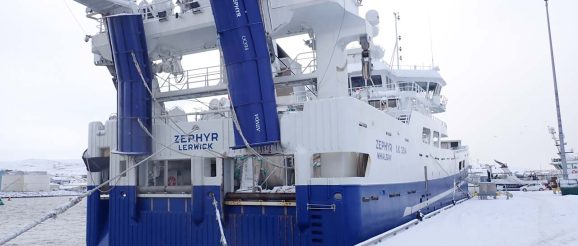Innovation and circumstance – the evolution of the Shetland pelagic fleet

Innovation and circumstance – the evolution of the Shetland pelagic fleet Innovation and circumstance – the evolution of the Shetland pelagic fleet
The manner in how the Shetland pelagic fleet evolved to its current position of eight large vessels was the result of a combination of factors – although the one element that has not changed is that the boats remain to this day locally crewed and largely family owned. The first significant herring fishery developed in the 1830s, before suffering a tumultuous period, and then resurrecting again in importance in the 1870s, thanks to new markets and new larger sailing drifters that could pursue the shoals further afield. A boom period followed thereafter, with curing stations springing up all over the islands. It peaked in 1905 when 110,000 tonnes, more than half the Scottish herring catch was landed in Shetland. The outbreak of the First World War brought a virtual end to the fishery in 1914, although it revived again once the war ended, but nowhere near to the same extent as before. Following the Second World War, whitefish gained greater importance for the islands, with fishing boats mixing their fishing operations between whitefish and herring depending on the season. In the 1960s, rather than the traditional drift net, purse seining became the revolutionary new method of catching herring. Norway was the pioneer of the purse-seine fishing technique and Shetlanders quickly followed suite to remain competitive. The result was that within a short time, traditional drift net or dual-purpose fishing boats disappeared, leaving vessels to either focus entirely on herring or whitefish. Those that concentrated on herring were largely based on the island of Whalsay on the east side of Shetland. With the decline of the herring fishery due to a collapse in stocks in the 1970s, purse seiners in the Shetland fleet turned their attention towards mackerel for which there was great demand in eastern Europe and the Soviet Union. Within a few years, the practice of transhipping catches of mackerel to eastern European and Russian factory ships (klondykers) at sea became a significant operation. This was enough to sustain Shetland and Scottish boats right through the 1980s (herring was also landed to klondykers when the fishery reopened in 1983) and until the mid-1990s. However, the collapse of the Soviet bloc and the removal of fuel subsidy payments for these highly inefficient klondykers quickly led to their demise. As this was happening, the Norwegians were investing heavily in their pelagic fleet and onshore processing facilities to supply emerging markets in the Far East and other parts of the world for high quality mackerel and herring. Thus, at considerable financial risk, Shetland fishing families invested in new vessels, and the fleet streamlined through the amalgamation of vessel licenses and their associated fixed quota allocations into fewer, but more efficient vessels, the cost of which was completely met by the industry. Despite the rationalisation into a smaller, more efficient operation, the family-owned, Whalsay-based Shetland pelagic fleet employ entirely local crews, and supports significant additional employment in processing, vessel maintenance, and a wide range of other support services.
